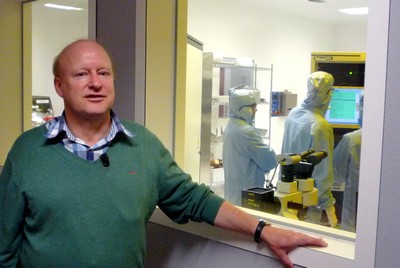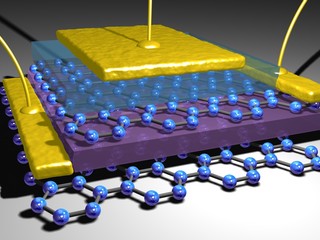Spinoza prize winner Bart van Wees: Innovative, smaller and better
Bart van Wees, Professor of Physics of Nanodevices at the Zernike Institute for Advanced Materials of the University of Groningen, is one of the four recipients of this year’s NWO Spinoza Prize, the highest distinction in Dutch academia. His research stems from his curiosity about the behaviour of electrons inside new materials, but he has always had at least half an eye on practical applications. ‘What do electrons do and how can you influence their properties? This is what I am trying to find out about with original experiments.’

The objects that Bart van Wees studies are usually only visible under an electron microscope: he builds nanodevices, electronic circuits with a core that consists of layers just one atom thick. At this scale, the laws of quantum mechanics dominate. ‘This subject already intrigued me when I was studying physics in Delft’, says Van Wees in his office in the physics and chemistry building on the Zernike Campus, where he has been working since his transfer from the Delft University of Technology in 1991.
‘At the time, I could not choose between regular physics and applied physics. I ended up doing my final-year project with Professor Hans Mooij, who was making tiny devices to study superconductivity.’
His PhD research studied the behaviour of electrons in semi-conductors and made him the first person to discover experimental proof of ‘quantized conductivity’, the phenomenon of gradual decrease of conductivity relative to gauge in extremely thin wires, which is now included in every textbook about solid-state physics. It was there that his fascination with electron behaviour was born. You would assume that physicists knew everything about electrons by now, but their behaviour inside all sorts of materials remains unpredictable. ‘We can always explain things afterwards, but surprises continue to occur’, says Van Wees.
Spin
After his transfer to the Zernike Institute of Advanced Materials in Groningen, his attention soon shifted to a new field, spintronics, which describes a quantum mechanical property of electrons, their ‘spin’. This can be best imagined by picturing electrons as small spheres spinning around their own axis, causing them to behave like small compass needles. This spin can assume two values: 'up’ or ‘down’, which makes it suitable, in principle, for storing or transporting information.

His knowledge of electron transport has enabled Van Wees to design systems that easily allow for spin transport, and the new insights thus gained have furthered our understanding of spin transport. ‘During that first period, there was a certain magic to parts of the field; things were working, but we did not know how.’
In one of his most-quoted articles, Van Wees describes how spin transport, like electron transport, always chooses the path of least resistance. This may seem obvious, but Van Wees’ ability to describe spin transport in an accessible manner is what turned the magic back into science. That is exactly what is needed to advance the field. Recently, he even managed to realize spin transport inside an insulator, that is to say a material that does not allow any electron transport at all.
Graphene
The discovery of graphene, a two-dimensional form of carbon that is an extremely good conductor of both electricity and heat, spurred further innovation. Spin transport inside graphene proved to offer numerous possibilities, and, again, Van Wees is furthering our understanding, mainly through the construction of devices in which different materials are often combined. ‘What do the electrons do then, and how can we use quantum physics to influence their properties? This is what I am trying to find out about with original experiments; it will increase our level of understanding.’ Eventually, this type of research might lead to even smaller transistors. In accordance with Moore’s Law, the number of transistors in integrated circuits has doubled every 24 months since 1965. However, the shrinking of transistors is reaching its limits, and new technology is needed to make the next step. Van Wees’ devices point the way to electronics beyond Moore’s Law.
But more understanding is needed still to achieve a real breakthrough. For example, Van Wees is currently stacking two different two-dimensional materials to find out how they influence each other. A postdoc from his lab, Niko Tombros, has even started a business that supplies this type of material to interested parties. The latest development is a combination of spin transport and heat transport. ‘This offers us the opportunity to produce electricity from heat differences in a more efficient manner.’
Van Wees’ work is highly regarded internationally, and his leading position can be seen in the important role he plays in the EU Graphene Flagship project. Between 2013 and 2023, Europe will be investing € 1 billion in fundamental research leading to the development of practical applications for graphene, such as super-small transistors. The project has been subdivided into a number of themes, with Van Wees in charge of the package that focuses on spintronics inside graphene.
Fascination
Even though Van Wees’ research group is now substantial in size, he still succeeds in having weekly meetings with his subgroups about their work. ‘Everyone drops by, from interns to post-docs.’ They all give short presentations about their progress, after which there is time for discussion and advice.
‘The people who join my group are fascinated by nano-scale applications and the quantum mechanics involved. Students and PhD candidates learn to think practically about fundamental issues here.’ This is no assembly line with uniform, repetitive tasks for everyone. ‘Everyone has to help formulate questions and design the relevant experiments. And if something worthwhile comes out of it, the next question is: how can I “sell” this, that is, publish it in a good journal.’
Students who obtain a Master’s degree or PhD in Van Wees’s lab have an understanding of technology and the associated physics. ‘And they should be able to distinguish between genuinely hot topics and hot air’, Van Wees adds. He stresses that it is also in society’s interest that academics are capable of giving advice and separating sense from nonsense.
As a designer of nanodevices, Van Wees feels an affinity with the pioneers of technology. He talks with great enthusiasm about the galleries at the Science Museum in London. ‘They include work by the builders of the first generation of computers, or the first steam engines. How they managed to do that, often through a combination of knowledge and intuition, is what appeals to me.’
The Spinoza Prize will enable Bart van Wees to keep on pioneering. Besides the honour of receiving the prize, he can spend EUR 2.5 million on research of his choice. He still needs to have a good think about how he will spend the money: ‘I could use it for my current research, but I will certainly use some of it to explore new territory too.’ His approach remains focused on making realistic devices, whose properties he prefers to discover at room temperature. ‘That’s because I always think about potential practical applications first’.
News from the Van Wees Lab @ Science LinX:
2018
New model brings spintronic transistor a step closer 9 January
2017
Controlling Spin Direction in Sandwiches of Two-dimensional Materials 4 December
That’s cool: spin transport in an insulator 11 April
The return of germanium transistors 28 February
Double success for PhD student with ‘spin relaxation’ 6 February
2016
Groundwork for spin transistor 14 September
Groningen researchers steer spin transport 21 July
Spinoza prize winner Bart van Wees: Innovative, smaller and better 13 June
Cooling graphene with electrons 24 May
2015
Groningen lab beats own world record 15 December
‘Wave’ sends information through magnet 14 September
2014
New nanoscale cooling element works in electrical insulators as well 14 July
2013
European Flagship with Groningen helmsman 30 January
| Last modified: | 12 March 2020 10.14 p.m. |
More news
-
10 June 2024
Swarming around a skyscraper
Every two weeks, UG Makers puts the spotlight on a researcher who has created something tangible, ranging from homemade measuring equipment for academic research to small or larger products that can change our daily lives. That is how UG...
-
21 May 2024
Results of 2024 University elections
The votes have been counted and the results of the University elections are in!

